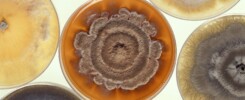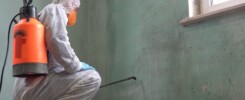Did you know that 70% of homes have mold present? Are you worried about the health risks of mold in your home?
Mold can be a serious problem, and it’s important to know how to spot it before it becomes a major issue. Not only can mold cause damage to your property, but it can also make you sick if left unchecked.
You don’t have to live with the fear of getting sick from mold in your home any longer! With our helpful guide, you will learn how to identify and remove mold safely so that you can enjoy living in a healthy environment.
Read on for more information about the health risks of mold and how to spot it!
Different Types of Mold
Mold is a type of fungus that can grow in damp and humid environments. It is often found indoors, where it can cause health issues if left unchecked. Mold spores are released into the air when disturbed, and these spores can be inhaled by people living in the home.
Long-term mold exposure has been linked to respiratory problems such as asthma and allergies, as well as other illnesses like fatigue and headaches. Therefore, it’s important to know how to spot mold before it becomes an issue so that you can take action quickly and protect your health from its potentially harmful effects.
The most common type of mold is Penicillium which often appears as soft, powdery green or blue patches. This type of mold usually thrives in damp areas and grows on:
- Carpets
- Paper
- Other materials
Aspergillus meanwhile is usually black and grows on food items such as spices and mushrooms. Alternaria produces brown spots whilst Stachybotrys chartsii – also known as black mold – can cause serious health problems if exposed to it for a long period.
There’s also:
- Mortierella
- Fusarium
- Mucor
While they don’t cause any major issues when inhaled, should never be ingested. Being aware of the different types of mold can help you to identify them quickly and take necessary steps to remove any growth that might harm your home or family.
Mold vs. Mildew
Mold and mildew are both fungi that cause the decomposition of organic materials, but there are a few differences that set them apart. Mold is typically fuzzy in appearance while mildew is a more powder-like substance. Mold typically developed on damp surfaces due to its high water content requirement.
Mildew usually requires low humidity levels to exist, making it common in buildings with poor ventilation. Another distinction between the two is that mold needs oxygen to grow whereas mildew can survive without it.
Understanding which type of fungi you’re dealing with is important when deciding which methods best address the growth and prevent it from returning!
Health Risks of Mold
Mold can cause a variety of health issues in humans, ranging from mild to more severe reactions. Allergies are common when mold spores are inhaled, such as:
- Coughing
- Sneezing
- Watery eyes
Those with weakened immune systems are particularly vulnerable to developing pneumonia or other serious lung infections after mold exposure. Long-term exposure can also be linked to mental health issues such as depression and anxiety.
It’s important to remember that mold can be hazardous if not detected early, so it’s best to keep an eye out for any signs of mold in the home.
Let’s take a look at some of the most common symptoms in detail.
Mold Can Cause Respiratory Problems
Mold can cause a variety of respiratory distress, including:
- Asthma
- Bronchitis
- Allergic reactions
People with mold allergies are especially at risk for these problems. Mold can also trigger symptoms in people with chronic lung diseases, such as COPD.
Mold Can Cause Skin Irritation
Mold can also cause skin irritation, especially in people with sensitive skin. The rash is usually red and itchy and can sometimes blister.
Mold Can Cause Headaches and Dizziness
Mold exposure can also cause headaches and dizziness in some people. These symptoms are usually caused by the release of toxins into the air that is produced by mold spores.
Mold Exposure Can Be Dangerous for Infants and Young Children
Infants and young children are especially at risk for health problems from mold exposure. This is because their immune systems are not yet fully developed and they may be more likely to breathe in mold spores.
Airborne Mold vs. Mold on Food
If you accidentally eat mold or breathe in mold spores, it is important to take action quickly as both can have serious health consequences. Eating moldy food can cause stomach upset and even poisoning if the mold contains mycotoxins.
Breathing in airborne molds can irritate your throat and lungs, leading to coughing and wheezing as well as more serious respiratory issues such as asthma attacks. To minimize the risk of health complications from eating or breathing in mold, it’s best to seek medical help right away if you suspect that you may have ingested or inhaled any type of mold.
Treating Mold-Related Illness
Mold is certainly a nuisance, but it can also be very dangerous. It’s important to take appropriate action if you think you have been exposed to mold—not only to remove the mold itself but to also treat any mold-related illnesses. Symptoms of a mold-related illness can include:
- Difficulty breathing
- Severe headaches
- Dizziness
- Eye irritations
If you notice these symptoms after mold exposure it’s essential that you seek immediate medical attention to identify the cause of your discomfort and receive treatment. Treating the symptoms of a mold-related illness can require professional guidance and possibly medication or further testing.
It’s best not to ignore any warnings from your body that something is wrong when it comes to mold exposure—it could end up saving your life one day!
How to Clean Mold Safely
Cleaning mold can be a daunting task, but it doesn’t have to be a scary one. The most important thing to remember is to follow safety precautions and always wear protective gear such as:
- Nonporous gloves
- Eye protection
- Face mask
When cleaning away the mold, use a non-ammonia detergent, wiping the area with a cloth or towel. Be sure that you get into the hard-to-reach areas where it is possible mold still lives.
If these areas need more attention or there is a larger patch of mold, contact an expert in mold removal who can use specific techniques and treatments to remove the mold safely. Cleaning up mold safely takes time and care, so don’t rush through the process; take your time and make sure when you’re done that all potential traces of the fungus are gone.
How to Spot Mold in the Home
Spotting the presence of mold in the home can be tricky but it’s essential if you want to keep your family safe and healthy. Thankfully, there are a few common signs to look out for.
A musty odor is one of the biggest indicators that mold might be present as this is usually due to moisture in the air. Similarly, water stains or discoloration on walls and ceilings could mean that there is excess humidity which allows mold to thrive. Additionally, large amounts of condensation on windows can also provide ideal conditions for mold growth so be sure to check areas that may not always get adequate ventilation.
If any of these things are spotted, it’s best to take immediate action and contact a professional mold assessor who can take steps to mitigate any risks associated with mold infestations.
Common Areas Around the House Where Mold Grows
Mold can grow in many parts of your home if given the chance. It loves damp, humid areas like bathrooms and basements, as well as:
- Behind wallpaper
- Under carpets
- Inside air ducts
Some appliances are also prone to mold growth, such as air conditioners and dehumidifiers. It’s a good idea to check for mold in these areas regularly, as well as any other area where water and moisture can accumulate, such as near windows or around pipes.
Finally, check your kitchen appliances regularly. Some fridges and dishwashers trap moisture, making them prime locations for mold growth. Be sure to check any areas that tend to stay wet and dry them immediately if you find any mold.
Are You Sick From Mold? Get Help Today
Mold is a serious issue that can cause health risks if not treated properly. If you believe your home has been affected by mold, it’s important to take the necessary steps to protect yourself and your family from its potential dangers.
If you believe you are sick from mold, don’t delay seeing your family doctor.
However, treating the source of the problem is equally as important. Contact Remediation Mold Tampa right away for professional help in identifying and cleaning up the mold in your home safely and effectively.


